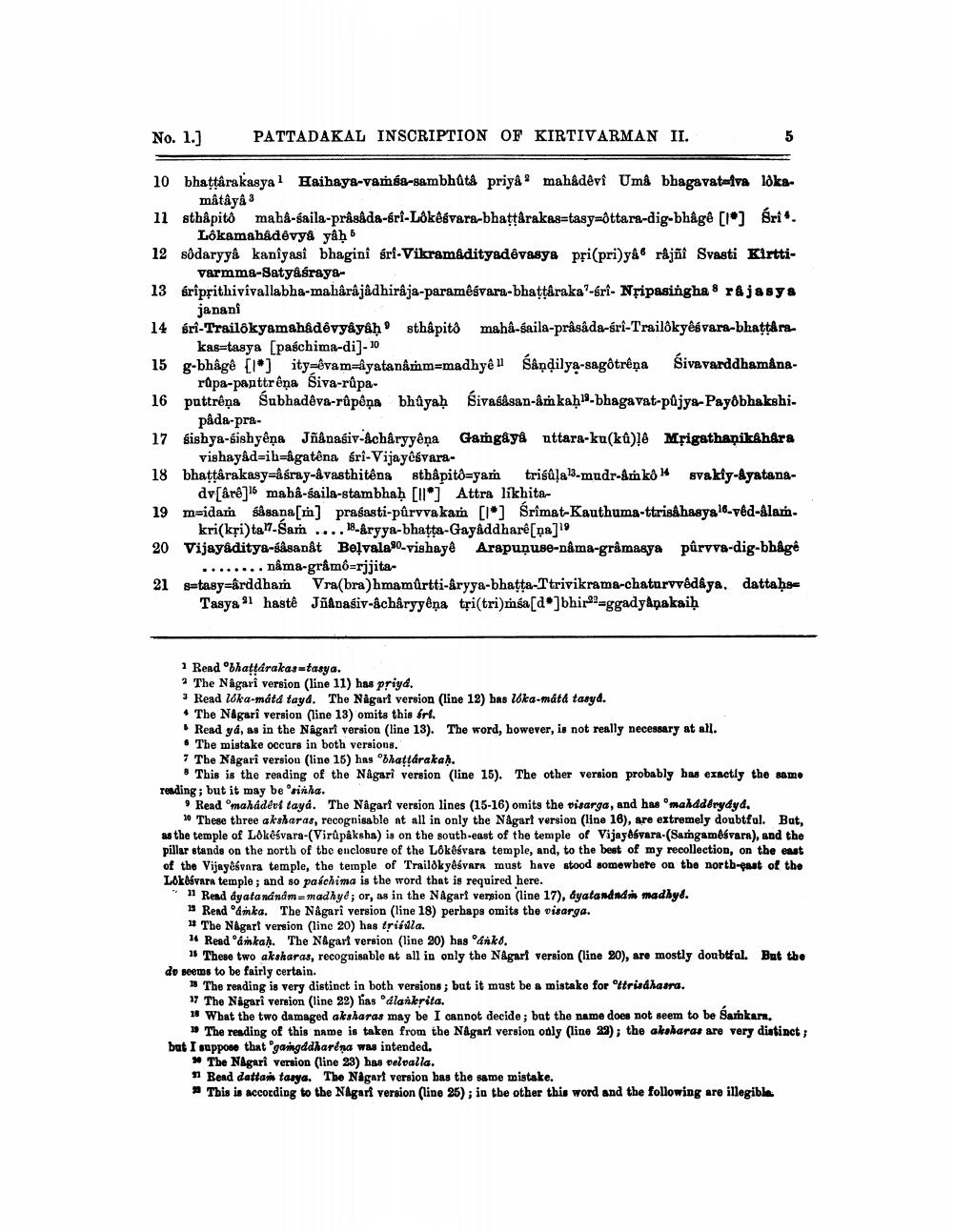________________
No. 1.]
10 bhattârakasya Haihaya-vamsa-sambhûtâ priyâ mahâdêvî Umâ bhagavat=iva lokamatky&
11 athapita maha-saila-présida-érl-Lökétvarn-bhattarakan-tasy-Uttara-dig-bhigė [*] Śri*.
PATTADAKAL INSCRIPTION OF KIRTIVARMAN II.
5
Lôkamahâdévya yâḥ
12 sôdaryya kaniyasi bhagini śri-Vikramadityadevasya pri(pri)yâ râjñî Svasti Kirttivarmma-Satyâśraya
13 riprithivivallabha-mahârâjādhirkja-paramidvara-bhaṭṭāraka-éri- Nṛipasingha rajasys
janani
14 śri-Trailôkyamahâdêvyâyâḥ sthâpitô mahâ-saila-prâsâda-śrî-Trailôkyêsvara-bhattara kas tasya [paschima-di]- 10
15 g-bhigh [1] ity-vam-iyatanimm-madhyê Sadilya-sagotripa
rupa-panttripa Siva-rips
16 patria Subhadéva-rappa bhayah Sivadlaan-ka-bhagavat-půjya-Payôbhakahi. pâda-pra
17 śishya-sishyêņa Jñânasiv-acharyyêna Gamgâyâ uttara-ku(kû)lê Mrigathanikâhara vishayad-ih-gatêna ári-Vijayisvara
18 bhattarakasy-ray-åvasthitêna sthåpito yam trisûla-mudr-âm kô svakiy-âyatanadv[ârê] mahâ-saila-stambhaḥ [*] Attra likhita
19 m=idam sâsana [m] prasasti-pûrvvakam [*] Śrimat-Kauthuma-ttrisâhasya16-véd-âlamkri(kri)ta-Sam....aryya-bhatta-Gayaddhart(pa]
20 Vijayaditya-sasanât Belvala-vishayê Arapupuse-nâma-grâmasya pûrvva-dig-bhâgê
.... nâma-grâmô=rjjita
21
tasyrddham Vra(bra)hmamürtti-kryya-bhaṭṭa-Ttrivikrama-chaturvvédâya, dattaḥa
21
Tasya hastê Jñanasiv-âchâryyêņa tri(tri)msa[d]bhir2=ggadyAnakaiḥ
Śivavarddhamana
1 Read bhattárakas tasya.
2 The Nagari version (line 11) has priya.
3 Read lóka-mátá taya. The Nagari version (line 12) has lóka-mátá tasya.
+ The Nagarî version (line 13) omits this ért.
Read yá, as in the Nagarî version (line 13). The word, however, is not really necessary at all.
The mistake occurs in both versions.
7 The Nagarî version (line 15) has bhaṭṭarakaḥ.
This is the reading of the Nagari version (line 15). The other version probably has exactly the same reading; but it may be 'sinha.
Read "mahadevi taya. The Nâgari version lines (15-16) omits the visarga, and has mahddérydyd,
10 These three aksharas, recognisable at all in only the Nagart version (line 18), are extremely doubtful. But, as the temple of Lôkêśvara-(Virûpâksha) is on the south-east of the temple of Vijayêévara-(Samgamêsvara), and the pillar stands on the north of the enclosure of the Lökêévara temple, and, to the best of my recollection, on the east of the Vijayêsvara temple, the temple of Trailôkyêśvara must have stood somewhere on the north-east of the Lokéévara temple; and so paschima is the word that is required here.
11 Read ayatananam madhye; or, as in the Nagari version (line 17), ayatandnám madhye.
1 Read amka. The Nâgarî version (line 18) perhaps omits the visarga.
"The Nagart version (line 20) has trisula.
14 Read 'ámkaḥ. The N&gart version (line 20) has °ánkó.
1 These two aksharas, recognisable at all in only the Nagarf version (line 20), are mostly doubtful. But the do seems to be fairly certain.
The reading is very distinct in both versions; but it must be a mistake for "ttrisáhasra.
17 The Nagari version (line 22) has álankrita.
18 What the two damaged aksharas may be I cannot decide; but the name does not seem to be Samkara.
The reading of this name is taken from the Nagari version only (line 23); the aksharas are very distinct; but I suppose that gamgddharéna was intended.
The Nagari version (line 23) has velvalla.
"Bead dattam tasya. The Nagart version has the same mistake.
This is according to the Nagarî version (line 25); in the other this word and the following are illegible.




